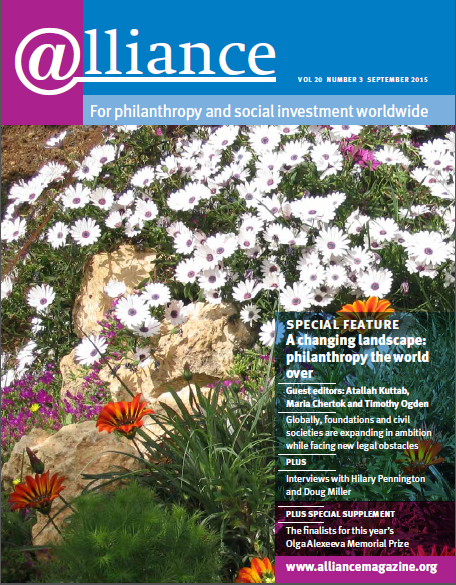Discussions about trends generally promote the ‘next best thing’ or the next great threat for philanthropy. In reality, most trends carry positive and negative implications, raising exciting and troubling questions that the thoughtful philanthropist and NGO leader must address in a changing landscape. My hope is, that when American philanthropic trends are considered, a balanced reflection can lead to more thoughtful, effective and powerful giving globally. While any one of these trends could fill a full issue of Alliance, I offer six, with brief consideration of their implications, as a quick ‘whistle-stop tour’ in hopes of sparking conversation.
Blurring boundaries between philanthropy and business – Social entrepreneurship, impact investing, venture philanthropy, social financing, and other practices blur the once clear divide between NGO and corporate activities, which raises a host of questions. What is the possible impact of a smaller grant budget on grantees and the field if more grant funds are allocated to social investments? How will this trend influence the dynamics of an investor-donor relationship? What are the beneficial and challenging dynamics of increased non-profit/corporate competition? What are the limits to investment when social enterprises offer a limited financial upside to balance the losses typical in a traditional high-risk equity investment portfolio? What are the limits of social enterprise as an approach to address underlying systemic issues of power, marginalization and inequality?
Expanding access to data – The proliferation of online giving data continues to grow, yet even as increasing amounts of data are available – including, soon, digital tax returns for non-profits – how data should be used remains an open question. In 2010, Hope Consulting found that while ‘donors say that how well a non-profit performs is important, few actively try to fund the highest-performing non-profits’. Although 90 per cent say non-profit performance is important, only 3 per cent conduct research to find the most effective ones. So how do we turn data into actionable knowledge?
Crowd funding offers a new way of raising funds – Crowd funding’s rapid growth has the potential to fundamentally shift traditional funding patterns. Platforms have evolved from first-generation structures with giving levels based on examples such as Heifer International’s Gift Catalog, to giving to specific vetted projects, and finally to third-generation giving to non-vetted projects on platforms like Kickstarter. Through this evolution, the volume of giving has increased as oversight has declined. Today, millions of donors make small (often non-tax-deductible) gifts to projects they discover through extended social networks without due diligence. Given this dramatic rise, should we reevaluate the relative impact of tax deductibility to motivate donors? How important will funding intermediaries remain?
Generational transitions in giving – The ‘next gen’ has been a regular topic in philanthropy, including in the December 2013 Alliance issue I guest edited. The influence of younger donors continues to grow. Changing social and economic dynamics including faster wealth accumulation from tech-based business ventures and a massive intergenerational transfer of money are expanding the pool of young major donors. As young people are giving bigger and stepping into foundation leadership roles, giving is changing. Increased mobility is weakening local attachments and globalization is expanding philanthropic interests, for example.
More people are ‘giving while living’ – There is growing momentum against the ‘perpetuity’ model, highlighted by Atlantic Philanthropies’ planned 2016 spend-out. Donors and foundation trustees who decide to ‘give it all now’ are largely driven by concerns about pressing problems today and worries that the priorities of future generations may change. Some face financial declines that raise doubts about long-term sustainability. While still a small minority, their funding decisions raise questions about the importance of legacy and future family engagement, and about the time needed to achieve impact.
Growing movement towards giving big – Lastly, with the increasing concentration of wealth and outreach by groups like Giving Pledge and Bolder Giving, we are witnessing a new age of ‘mega donors’. For individual donors, these public commitments invite reflection on how much and why they should give. Questions about new major donors’ influence in a field and how other funders will respond should keep funders and NGO leaders on the edge of their seats. Finally, we must ask how the growing trend of mega donors will effect elite influence on social and political development and how these donors will influence our culture of giving.
Jason Franklin, PhD, WK Kellogg Community Philanthropy Chair, Dorothy A. Johnson Center for Philanthropy.




Comments (0)